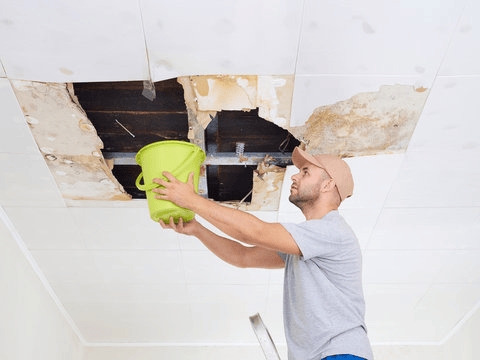Living in Brooklyn, I’ve noticed that when a roof springs a leak, the trouble doesn’t just stay up there—it finds its way inside, right into our ceilings. If you’ve ever looked up and spotted a brown spot that wasn’t there last week, you’ve likely run into the early warning signs of Ceiling Water Damage. It’s a sneaky process, often starting in one small spot and slowly spreading until you have a real mess on your hands. Let’s walk through how this damage unfolds, what you should look out for, and what you can do about it.
How the Drip Becomes a Disaster
Water always finds a way. After a heavy rain or a melting snowstorm, if your roof has even the tiniest crack, water will seep through. This is especially true in Brooklyn, where historic brownstones and row houses have roofs that see everything from blizzards to summer storms. The leak might start at the roof, but gravity does its job—pulling the water down until it pools above your ceiling.
At first, you might not notice anything. The insulation and wood framing above your ceiling act like a sponge, soaking up moisture. Over time, though, the water builds up. The first visible sign is usually a stain, kind of like a coffee ring, on the ceiling. If you ignore it, the stain gets darker, and the paint or plaster might start to peel or bubble. The spot can even sag or crack, especially after another round of rain. What started as a drip can become a full-blown ceiling collapse if it’s not fixed.
Key Features of Ceiling Water Damage
| Feature | What It Looks Like | Why It Matters |
|---|---|---|
| Staining | Brown, yellow, or copper-colored rings | First clue water is seeping above your ceiling |
| Peeling Paint | Bubbled, cracked, or flaking paint | Shows moisture is trapped inside |
| Sagging | Ceiling appears curved or droopy | Signals water is pooling and may cause collapse |
| Mold & Musty Smell | Black spots or earthy odors | Indicates long-term moisture—can affect health |
| Visible Leaks | Dripping or wet spots | Active leak needs fast action |
Why Safety Comes First
Ceiling Water Damage isn’t just ugly—it can be downright dangerous. When water soaks into your ceiling, it weakens the structure. Sometimes, a section of the ceiling can give way without much warning, sending soggy plaster or drywall crashing down. If there’s wiring in the ceiling, water can create the perfect setup for an electrical hazard. That’s why, if you hear dripping or see bulging in the ceiling, it’s important to keep people and pets out of the room until you know it’s safe.
Mold is another sneaky problem. Once moisture gets trapped, mold spores can start to grow within a day or two. For anyone with allergies or breathing issues, this can make things worse quickly. If you spot black marks or notice a musty smell, it’s a sign you need to bring in help fast.
Counting the Cost: What to Expect
Fixing Ceiling Water Damage can get expensive, especially if you let it linger. In Brooklyn, costs can swing a lot depending on how big the damage is and how quickly you catch it. Small stains might only need a little patchwork and paint. But if the water has soaked into the beams, insulation, or wiring, you might be looking at major repairs—and big bills.
What really adds to the cost is letting the problem drag on. Mold cleanup, structural repairs, and electrical fixes all add up. It’s always cheaper to patch a small leak today than rebuild a ceiling tomorrow.
What to Do When It’s an Emergency
Sometimes, you don’t have the luxury of waiting. If water is pouring in or the ceiling looks ready to cave, it’s time for emergency service. Most Brooklyn contractors have teams on call for just these situations. The first thing they’ll do is stop the water—either by covering the roof or patching the leak. Then, they’ll check the ceiling for safety and start drying things out. Acting fast can save your home from bigger headaches down the line.
While you wait for help, turn off the electricity in the affected area if you can do it safely. Move furniture and valuables away from the drip zone. And don’t poke or prod at the bulging part of the ceiling—it might be holding more water than you think.
Frequently Asked Questions
A: Look for stains, peeling paint, saggy spots, or a musty smell. If you see any of these, there’s a good chance water is getting in from above.
A: Not always, but in Brooklyn, roof leaks are a top culprit. Plumbing leaks or condensation from AC units can also be to blame.
A: Try to find and stop the source of water, then call a professional to check the damage. Don’t ignore the problem—quick action can save you time and money.
A: Small stains might be a DIY project, but bigger issues, especially if there’s mold or structural damage, need a pro’s touch.
A: Often yes, if the damage was sudden and accidental. It’s best to check your policy or call your insurance provider.
Wrapping Up
Ceiling Water Damage is one of those problems that waits for no one. A tiny leak can quietly turn into a big headache before you know it, especially in the ever-changing weather of Brooklyn. The best way to avoid major trouble is to act fast—keep an eye out for early signs, make quick repairs, and call in help when you need it. Your ceiling might not thank you, but your wallet definitely will!







0 Comments